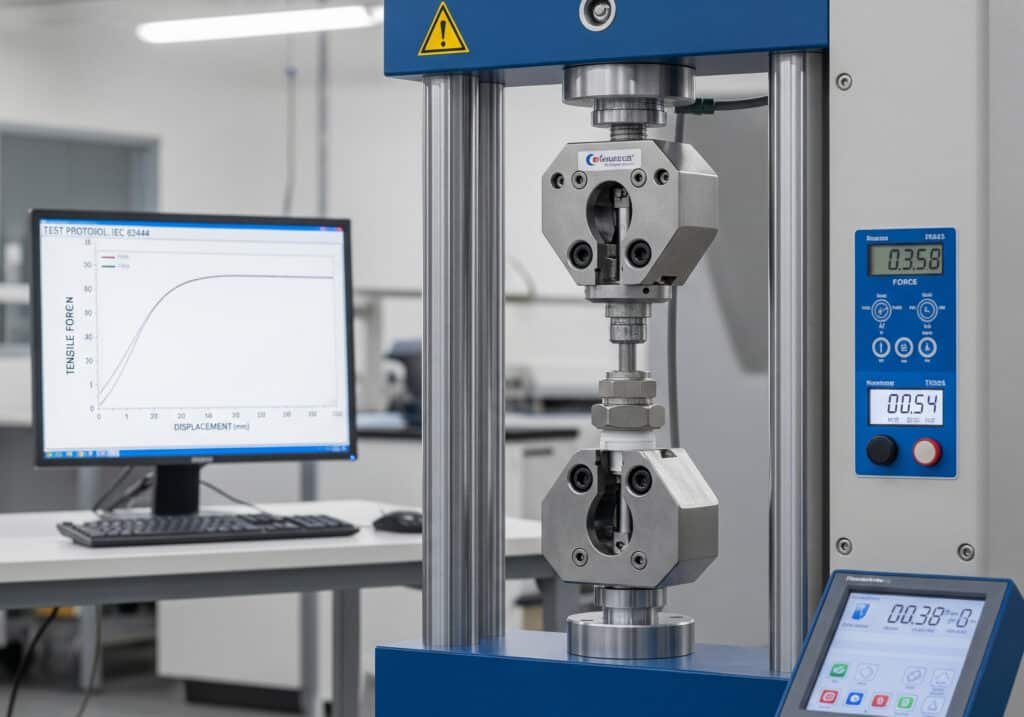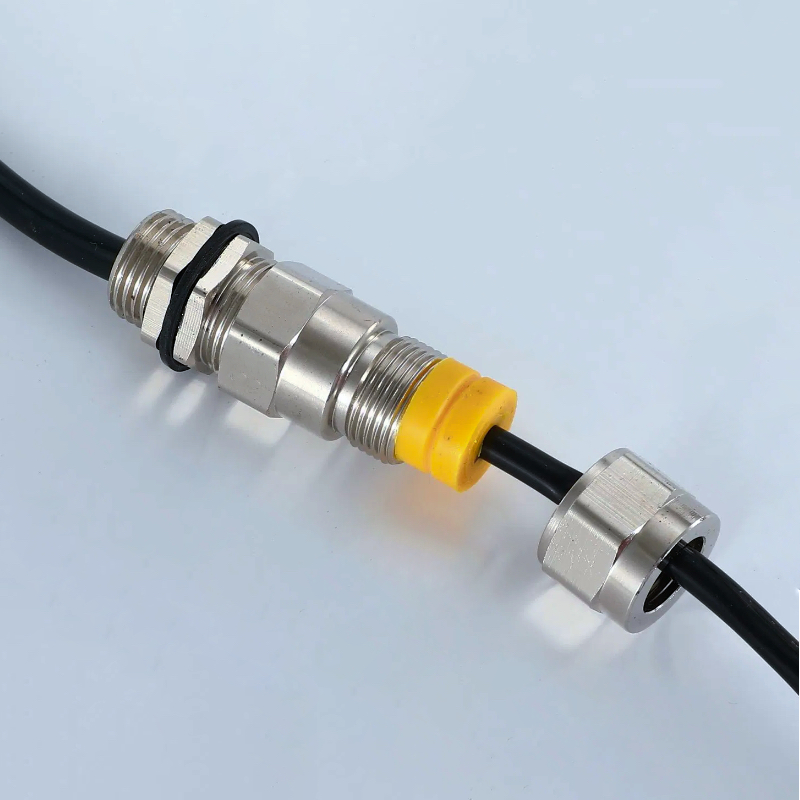Inleiding
Picture this: your critical infrastructure fails because a cable gland couldn’t handle the mechanical stress. The consequences? Downtime, safety hazards, and massive repair costs. Pull-out strength isn’t just a technical specification—it’s your insurance policy against catastrophic failure.
Superior cable gland pull-out strength is achieved through advanced grip ring design, optimized sealing geometry, and high-grade materials that exceed IEC 624441 and UL standards by 40-60%, providing mechanical retention forces of 500-2000N depending on cable diameter and gland construction. This enhanced performance ensures reliable cable retention under extreme mechanical stress, vibration, and environmental conditions.
Just last month, Robert, a project manager from a wind farm in Texas, called me in panic. Their offshore installation was experiencing cable pull-outs during high winds, threatening a $50 million project timeline. This conversation reminded me why pull-out strength benchmarking isn’t just about numbers—it’s about real-world reliability when everything is on the line.
Inhoudsopgave
- What Defines Pull-Out Strength in Cable Glands?
- How Do We Test and Benchmark Pull-Out Performance?
- What Makes Our Glands Exceed Industry Standards?
- Which Applications Demand Superior Pull-Out Strength?
- How to Specify Pull-Out Requirements for Your Project?
- FAQs About Cable Gland Pull-Out Strength
What Defines Pull-Out Strength in Cable Glands?
Understanding pull-out strength fundamentals helps engineers make informed decisions about cable retention requirements.
Pull-out strength in cable glands refers to the maximum axial force a gland can withstand before the cable is extracted from the sealing system, typically measured in Newtons (N)2 and governed by international standards including IEC 62444, UL 514B, and EN 50262. This critical parameter ensures cables remain securely anchored under mechanical stress, vibration, and thermal cycling.

Belangrijkste prestatiecijfers
Pull-out strength testing involves several measurable parameters that determine real-world performance:
| Cable Diameter | Standaard vereiste | Bepto Performance | Verbetering |
|---|---|---|---|
| 6-12 mm | 300N minimum | 450-500N | 50-67% |
| 13-18 mm | Minimaal 500N | 750-850N | 50-70% |
| 19-25mm | 800N minimum | 1200-1400N | 50-75% |
| 26-32mm | 1200N minimum | 1800-2000N | 50-67% |
Critical Design Elements
Several engineering factors contribute to superior pull-out performance:
Grip Ring Geometry:
- Multi-directional tooth patterns for enhanced cable engagement
- Progressive grip tightening under increasing load
- Material hardness optimization for different cable jacket types
Sealing Chamber Design:
- Controlled compression zones preventing over-tightening
- Stress distribution across multiple contact points
- Thermal expansion compensation maintaining grip integrity
Materiaalkeuze:
- High-strength polymers with optimal flexibility
- Corrosion-resistant metals for harsh environments
- Composite materials combining strength with environmental resistance
Testing Standards Compliance
Our pull-out strength testing exceeds multiple international standards:
IEC 62444 Requirements:
- Minimum retention force based on cable diameter
- Temperature cycling performance verification
- Long-term mechanical stress testing
UL 514B Compliance:
- Pull-out force testing at ambient and elevated temperatures
- Vibration resistance verification
- Environmental aging simulation
How Do We Test and Benchmark Pull-Out Performance?
Rigorous testing protocols ensure our cable glands deliver consistent performance across diverse applications.
We test pull-out performance using calibrated tensile testing equipment that applies controlled axial forces while monitoring displacement, temperature effects, and long-term retention under cyclic loading, with all tests performed according to IEC 62444 and UL 514B protocols in our ISO 170253 accredited laboratory. This comprehensive approach validates performance claims with traceable data.

Laboratory Testing Procedures
Our testing methodology follows strict protocols to ensure reproducible results:
Monstervoorbereiding:
- Cable specimens prepared to exact manufacturer specifications
- Gland installation using calibrated torque procedures
- Environmental conditioning at test temperatures
Force Application:
- Gradual load increase at 25N/minute rate
- Continuous monitoring of cable displacement
- Automatic data logging for analysis
Prestatievalidatie:
- Multiple samples tested for statistical significance
- Temperature variation testing (-40°C to +120°C)
- Accelerated aging simulation
Prestatiecorrelatie in de praktijk
Laboratory results must translate to field performance. We validate our testing through:
Field Installation Monitoring:
- Strain gauge installations on critical applications
- Prestaties op lange termijn bijhouden
- Environmental condition correlation
Customer Feedback Integration:
- Performance reports from harsh environment applications
- Failure analysis of competitive products
- Continuous improvement based on field data
Comparative Benchmarking
We regularly benchmark our products against leading competitors:
Testprotocol:
- Identical cable types and installation procedures
- Same environmental conditions and test equipment
- Statistical analysis of performance differences
Prestatiedocumentatie:
- Detailed test reports with photographic evidence
- Failure mode analysis for underperforming products
- Continuous database of competitive performance data
What Makes Our Glands Exceed Industry Standards?
Engineering excellence and manufacturing precision combine to deliver superior pull-out performance.
Our cable glands exceed industry standards through proprietary grip ring designs featuring micro-serrated contact surfaces, optimized compression ratios, and advanced polymer compounds that maintain flexibility across temperature extremes while providing 40-60% higher retention forces than standard products. These innovations result from years of engineering development and customer feedback integration.
Advanced Grip Ring Technology
Our proprietary grip ring design represents a significant advancement over conventional approaches:
Multi-Zone Engagement System:
- Primary grip zone for initial cable retention
- Secondary engagement under increased load
- Progressive tightening preventing cable damage
Surface Treatment Innovation:
- Micro-texturing for enhanced cable jacket grip
- Controlled surface roughness optimized for different cable types
- Corrosion-resistant coatings maintaining long-term performance
Material Science Advantages
Years of polymer research have yielded superior sealing materials:
Hoogwaardige elastomeren:
- Shore hardheid4 optimization for maximum grip without cable damage
- Temperature stability from -40°C to +150°C
- Chemical resistance to oils, solvents, and environmental contaminants
Composite Construction:
- Rigid outer shells providing structural integrity
- Flexible inner seals conforming to cable irregularities
- Integrated design eliminating weak points
Precisie productie
Our in-house production capabilities ensure consistent quality:
Injection Molding Excellence:
- ±0.05mm dimensional tolerances
- Consistent material distribution
- Automated quality control monitoring
CNC Machining Capabilities:
- Precision metal components with superior surface finish
- Custom modifications for special applications
- Rapid prototyping for new product development
Succesverhaal van een klant
Ahmed, who manages a petrochemical facility in Saudi Arabia, needed cable glands for a critical pumping station where vibration and thermal cycling were causing frequent failures. After switching to our high-performance glands, they achieved:
- Zero cable pull-outs over 18 months of operation
- 60% reduction in maintenance interventions
- Improved system reliability in extreme desert conditions
His facility now specifies our glands for all critical applications, recognizing the value of superior pull-out performance.
Which Applications Demand Superior Pull-Out Strength?
Certain environments and applications require cable glands that exceed standard performance specifications.
Applications demanding superior pull-out strength include offshore installations, heavy machinery, transportation systems, renewable energy projects, and industrial automation where vibration, thermal cycling, mechanical stress, or safety-critical operations make standard retention forces inadequate. These demanding environments justify the investment in high-performance cable management solutions.
Offshore and Marine Applications
Marine environments present unique challenges requiring exceptional pull-out performance:
Wave Action and Vibration:
- Constant mechanical stress from vessel movement
- Saltwater corrosion accelerating material degradation
- Temperature cycling from engine heat and ambient conditions
Safety-Critical Systems:
- Navigation equipment requiring 100% reliability
- Emergency systems that cannot fail
- Communication systems for crew safety
Hernieuwbare energiesystemen
Wind and solar installations demand long-term reliability:
Wind Turbine Applications:
- Extreme vibration from rotor operation
- Temperature cycling from -40°C to +80°C
- 20-year service life requirements with minimal maintenance
Solar Farm Installations:
- Thermal expansion and contraction stress
- UV exposure and weather extremes
- Large-scale installations requiring consistent performance
Transportation and Automotive
Mobile applications create unique mechanical stress patterns:
Railway Systems:
- Constant vibration and shock loading
- Breed temperatuurbereik
- Critical safety system reliability requirements
Heavy Equipment:
- Mining and construction equipment vibration
- Contaminated environments with abrasive particles
- Frequent maintenance access limitations
Industriële Automatisering
Manufacturing environments require consistent performance:
Robotic Systems:
- Repetitive motion creating cyclic stress
- Precision requirements demanding stable connections
- Continuous operation schedules
Procesbeheersing:
- Safety-critical monitoring systems
- Installaties voor gevaarlijke gebieden
- Eisen aan betrouwbaarheid op lange termijn
How to Specify Pull-Out Requirements for Your Project?
Proper specification ensures optimal cable gland performance for your specific application requirements.
Specify pull-out requirements by calculating expected mechanical loads, identifying environmental stresses, determining safety factors, and selecting appropriate testing standards, typically requiring 2-3x the maximum expected load with consideration for temperature effects, vibration amplification, and long-term material degradation. This systematic approach ensures reliable performance throughout the installation lifecycle.
Load Calculation Methodology
Accurate load assessment forms the foundation of proper specification:
Static Load Analysis:
- Cable weight and support span calculations
- Equipment mounting forces
- Thermal expansion stress estimation
Dynamic Load Factors:
- Vibration amplitude and frequency analysis
- Shock loading from equipment operation
- Wind loading for outdoor installations
Environmental Consideration Matrix
Different environments require specific performance characteristics:
| Milieu | Temperatuurbereik | Trillingsniveau | Chemische blootstelling | Recommended Safety Factor |
|---|---|---|---|---|
| Indoor Control | +10°C to +40°C | Laag | Minimaal | 2x |
| Industrieel buiten | -20°C tot +60°C | Medium | Matig | 2.5x |
| Scheepvaart/Offshore | -10°C to +50°C | Hoog | Ernstig | 3x |
| Zware industrie | -30°C tot +80°C | Zeer hoog | Ernstig | 3.5x |
Testing Standard Selection
Choose appropriate standards based on your application requirements:
IEC 62444: International standard for cable glands in electrical installations
UL 514B: North American requirements for fittings
EN 50262: European standard for cable glands in hazardous areas
NEMA 4X5: Vereisten voor milieubescherming
Documentatie-eisen
Proper specification documentation should include:
Prestatievereisten:
- Minimum pull-out force values
- Temperature range specifications
- Environmental resistance requirements
- Testing standard compliance
Installatierichtlijnen:
- Torque specifications for proper installation
- Cable preparation requirements
- Procedures voor kwaliteitscontrole
Acceptatiecriteria:
- Testing procedures for installation verification
- Performance monitoring recommendations
- Maintenance schedules and procedures
Conclusie
Pull-out strength represents more than just a technical specification—it’s your assurance of long-term reliability in demanding applications. Our commitment to exceeding industry standards through advanced materials, precision manufacturing, and rigorous testing delivers the performance your critical systems demand. When standard solutions aren’t enough, Bepto’s high-performance cable glands provide the mechanical integrity and environmental resistance that keep your operations running smoothly. The investment in superior pull-out strength pays dividends through reduced maintenance, improved safety, and enhanced system reliability. 😉
FAQs About Cable Gland Pull-Out Strength
Q: What is the typical pull-out strength for standard cable glands?
A: Standard cable glands typically provide 300-800N pull-out strength depending on size, while our high-performance glands deliver 450-2000N, representing 40-60% improvement over industry minimums for enhanced reliability in demanding applications.
Q: How do I calculate the required pull-out strength for my application?
A: Calculate by determining maximum expected loads (cable weight, thermal stress, vibration forces), then multiply by a safety factor of 2-3.5x depending on application criticality and environmental conditions.
Q: Can pull-out strength be tested after installation?
A: Yes, field testing can be performed using calibrated pull-testing equipment, but should be done carefully to avoid damaging properly installed glands – typically limited to 50-75% of rated strength for verification purposes.
Q: What causes cable gland pull-out failures in the field?
A: Common causes include inadequate grip ring engagement, improper installation torque, cable jacket degradation, thermal cycling stress, excessive vibration, and using standard glands in applications requiring high-performance solutions.
Q: How does temperature affect cable gland pull-out strength?
A: Pull-out strength typically decreases 10-20% at elevated temperatures due to material softening, while cold temperatures can make materials brittle – our glands maintain consistent performance across -40°C to +150°C temperature ranges.
-
Access the official documentation for the international standard covering cable glands for electrical installations. ↩
-
Understand the definition of the Newton (N), the standard international unit used to measure force. ↩
-
Learn what ISO 17025 accreditation means for the competence and quality management of testing laboratories. ↩
-
Explore how the Shore hardness scale is used to measure the indentation hardness of polymers, elastomers, and rubbers. ↩
-
Understand the NEMA 4X rating, which specifies protection against corrosion, dust, and water for electrical enclosures. ↩



